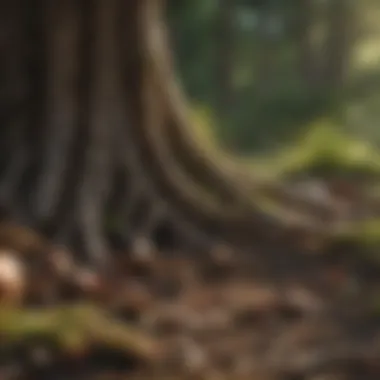Discover Sustainable Solutions for Tree Trimmings Disposal


Overview of the Topic
Trees are invaluable contributors to the environment, providing oxygen, regulating temperature, and sheltering diverse ecosystems. Tree trimmings, often overlooked, play a crucial role in maintaining tree health and promoting growth. Proper disposal of tree trimmings is essential to environmental sustainability and eco-conscious practices.
Current Status and Challenges
The current disposal methods for tree trimmings involve landfill dumping or burning, which pose environmental risks and contribute to air and soil pollution. Improper disposal can lead to habitat destruction, nutrient depletion, and increased greenhouse gas emissions. The challenges lie in promoting awareness about sustainable disposal techniques and encouraging individuals to adopt eco-friendly practices.
Sustainable Solutions
To address the challenges surrounding tree trimmings disposal, sustainable solutions such as composting and mulching have emerged as effective alternatives. Composting transforms tree trimmings into nutrient-rich soil amendments, supporting plant growth and reducing waste. Mulching involves shredding tree trimmings to create a protective layer that conserves moisture, suppresses weeds, and enhances soil health. Success stories of communities embracing these practices showcase the positive impact of sustainable waste management on local environments.
Impact and Importance
The impact of negligent tree trimmings disposal extends beyond immediate environmental consequences to long-term repercussions on biodiversity and ecosystems. By prioritizing responsible disposal practices, individuals can contribute to preserving habitat integrity, fostering wildlife diversity, and mitigating climate change effects. The importance of conservation efforts cannot be overstated, as sustainable resource use is vital for safeguarding natural resources and ensuring a greener future for upcoming generations.
Understanding Tree Trimmings Disposal
Tree trimmings disposal is a critical aspect of maintaining the ecological balance in our immediate environment. Proper disposal not only ensures the tidiness of our surroundings but also plays a significant role in promoting sustainability. By efficiently managing tree trimmings, we can contribute to reducing waste and creating a more eco-friendly habitat. This section will delve into the various dimensions of tree trimmings disposal, ranging from understanding its importance to exploring effective techniques.
Importance of Proper Disposal
When it comes to tree trimmings disposal, understanding the importance of proper waste management is paramount. Why does it matter, you ask? The answer lies in the environmental impact. In this context, proper disposal minimizes the accumulation of organic waste, thereby preventing potential hazards such as pest infestation or air pollution. By adopting responsible disposal practices, individuals can actively participate in preserving the ecosystem and promoting a cleaner, healthier environment.
Why it Matters
The significance of efficient tree trimmings disposal stems from its direct influence on the overall ecosystem. Proper disposal methods not only prevent the proliferation of waste but also contribute to the nourishment of soil health. Moreover, appropriate waste management reduces the carbon footprint, aligning with sustainability goals. Embracing eco-friendly disposal practices is crucial for maintaining environmental equilibrium and fostering a greener planet.
Impact on Environment


The impact of tree trimmings disposal on the environment cannot be overstated. Improper disposal can lead to soil degradation, water contamination, and overall ecological imbalance. By recognizing the consequences of inadequate waste management, individuals can make informed decisions to protect natural resources and preserve biodiversity. Considering the environmental implications of our actions is essential for promoting a harmonious coexistence with nature.
Types of Tree Trimmings
In the realm of tree trimmings, diverse components such as branches, leaves, and twigs demand proper handling to ensure effective disposal and potential reuse. Understanding the distinctive characteristics of each type of trimming is pivotal in implementing suitable waste management strategies.
Branches
Branches constitute a substantial portion of tree trimmings, often requiring specialized treatment due to their size and density. Proper handling of branches involves thoughtful pruning and strategic placement within the disposal system to facilitate decomposition. While branches offer valuable organic matter for mulching and composting, their efficient disposal is integral to maintaining a tidy outdoor space.
Leaves
Leaves, being versatile components of tree trimmings, can serve multiple purposes in the disposal process. Their high nitrogen content makes them ideal for composting, enriching the soil with essential nutrients. However, excessive accumulation of leaves can obstruct natural processes and hinder plant growth. Therefore, careful management of leaf disposal is essential to harness their potential benefits while preventing environmental repercussions.
Twigs
In the realm of tree trimmings, twigs represent a crucial element that demands attention during disposal. These smaller branches may seem inconspicuous, but their accumulation can affect the aesthetic appeal and ecological balance of outdoor spaces. Integrating twigs into mulching practices provides an eco-friendly solution to enhance soil fertility and moisture retention. Understanding the role of twigs in the broader context of waste management is key to maximizing their utility and decreasing environmental impact.
Eco-Friendly Disposal Techniques
In this section, we will delve deep into the crucial importance of Eco-Friendly Disposal Techniques within the broader context of responsible tree trimmings management. By focusing on sustainability and eco-consciousness, employing these techniques becomes imperative for individuals and communities alike. Not only do they aid in reducing waste but also contribute to environmental preservation by promoting natural processes of decomposition and reuse. It is essential to understand the specific elements and benefits of Eco-Friendly Disposal Techniques to grasp their significance fully.
Composting
Process Overview
Composting plays a pivotal role in the eco-friendly disposal of tree trimmings by facilitating the natural decomposition of organic matter. This process involves creating a balanced environment for microorganisms to break down organic materials, including branches, leaves, and twigs, into nutrient-rich compost. One key characteristic of composting is its ability to transform waste into a valuable resource, enriching the soil and supporting plant growth. The unique feature of composting lies in its sustainability aspect, where organic waste is recycled back into the ecosystem, reducing the need for chemical fertilizers. Despite its many advantages, such as soil enrichment and waste reduction, composting also faces challenges like proper maintenance and monitoring to ensure optimum decomposition rates.
Benefits


The benefits of composting are manifold, contributing significantly to sustainable waste management practices. Composting helps reduce landfill waste, minimizing the environmental impact of tree trimmings disposal. By producing nutrient-rich compost, this technique not only nourishes soil but also aids in water conservation and reduces greenhouse gas emissions. The key characteristic of composting is its promotion of circular economy principles, where organic waste is transformed into a valuable resource, aligning with the goal of environmental sustainability. However, challenges like proper aeration and moisture control need to be addressed to optimize the composting process effectively.
Mulching
Advantages
Mulching offers various advantages in the eco-friendly disposal of tree trimmings by acting as a protective layer over soil. One key characteristic of mulching is its ability to regulate soil temperature, conserve moisture, and suppress weed growth, promoting optimal plant development. The unique feature of mulching lies in its versatility, suitable for different types of plant species and soil conditions. While its advantages include erosion prevention and soil enrichment, mulching may pose challenges like nutrient leaching and inappropriate selection of mulching materials.
Best Practices
Embracing best practices in mulching is essential for maximizing its benefits and minimizing potential drawbacks. By selecting the right mulching materials, maintaining proper thickness, and avoiding contact with plant stems, individuals can ensure effective weed suppression and moisture retention. The key characteristic of best practices in mulching is their role in enhancing soil structure, promoting microbial activity, and preventing soil compaction. However, challenges such as mulch decomposition rate and material sourcing need to be carefully considered to achieve sustainable mulching outcomes.
Chipping
Usage
Chipping serves as a practical solution for eco-friendly disposal of tree trimmings by converting them into smaller wood chips or mulch. One key characteristic of chipping is its versatility in processing various types of tree trimmings efficiently, making it a popular choice for landscape maintenance and waste reduction. The unique feature of chipping lies in its ability to repurpose tree trimmings into valuable landscaping materials, supporting sustainable land management practices. Despite its advantages in weed suppression and erosion control, challenges like equipment maintenance and safety precautions must be managed to ensure safe and effective chipping operations.
Considerations
Considerations in chipping play a crucial role in optimizing its benefits and mitigating potential risks. By adhering to safety guidelines, maintaining equipment regularly, and considering chip size and distribution, individuals can achieve effective tree trimmings disposal through chipping. The key characteristic of considerations in chipping is their impact on operational efficiency, cost-effectiveness, and environmental sustainability. However, challenges like noise pollution and particle emissions need to be addressed through proper planning and risk management strategies.
Community Engagement
Community engagement holds immense significance in the realm of responsible tree trimmings disposal. By involving local communities in the process, we not only spread awareness about sustainable practices but also foster a sense of collective responsibility towards the environment. The benefits of community engagement extend beyond just disposal methods; they include building stronger community bonds, promoting environmental stewardship, and encouraging active participation in conservation efforts. Considerations such as language barriers, cultural differences, and varying levels of environmental awareness need to be addressed to ensure effective engagement with diverse community groups.
Local Recycling Programs** - **Benefits
Local recycling programs play a crucial role in promoting sustainable waste management practices. One of the key benefits of these programs is their contribution to reducing landfill waste and conserving natural resources. By promoting the recycling of tree trimmings, these programs help divert organic waste from landfills, thereby reducing greenhouse gas emissions and supporting the local ecosystem. The unique feature of local recycling programs lies in their ability to turn organic waste into valuable compost or mulch, which can then be used to enrich soil health and enhance green spaces.


Local Recycling Programs** - **Participation
Active participation in local recycling programs is essential for their success and sustainability. By encouraging community members to segregate and dispose of tree trimmings responsibly, these programs promote a culture of waste reduction and resource conservation. The key characteristic of participation lies in its role in creating a sense of environmental responsibility among individuals and fostering a collective commitment to sustainable practices. While the advantages of participation include reduced waste generation and increased recycling rates, challenges such as lack of awareness, infrastructure limitations, and behavioral barriers can hinder widespread participation.
Educational Workshops** - **Promoting Sustainability
Educational workshops play a vital role in promoting sustainability and disseminating knowledge about eco-friendly tree trimmings disposal techniques. By focusing on topics such as composting, mulching, and waste reduction, these workshops empower participants to make informed decisions regarding waste management. The key characteristic of promoting sustainability through workshops is its ability to bridge the gap between knowledge and action, inspiring individuals to adopt sustainable practices in their daily lives. The advantages of these workshops extend to creating a ripple effect of positive environmental actions within communities, leading to long-term benefits for the ecosystem.
Educational Workshops** - **Guidelines
Guidelines provided during educational workshops serve as practical roadmaps for implementing sustainable waste management strategies. By offering step-by-step instructions on composting, mulching, and other disposal techniques, these guidelines equip participants with the necessary skills to effectively manage tree trimmings. The unique feature of workshop guidelines is their adaptability to different settings and resource constraints, making them accessible to a wide range of audiences. While the advantages of following these guidelines include reduced waste sent to landfills and improved soil health, challenges such as resource limitations and lack of follow-up support can impact the successful implementation of these practices.
Innovative Solutions
In this section, we will delve into the significance of innovative solutions within tree trimmings disposal. By exploring cutting-edge methods such as bioenergy production and upcycling projects, we aim to push the boundaries of sustainability and eco-conscious practices. Innovative solutions play a crucial role in revolutionizing the traditional approach to waste management. They offer a fresh perspective on utilizing natural resources efficiently while minimizing environmental impact. By focusing on innovation, we can develop sustainable practices that benefit both the ecosystem and our communities.
Bioenergy Production
Concept
Bioenergy production involves harnessing energy from organic materials like tree trimmings through processes such as anaerobic digestion or combustion. This approach contributes to our overall goal of promoting clean energy sources and reducing reliance on fossil fuels. The key characteristic of bioenergy production lies in its ability to transform organic waste into a renewable energy source. This not only helps in waste reduction but also aids in mitigating greenhouse gas emissions. The unique feature of bioenergy production is its cyclic nature, where carbon dioxide released during energy generation is reabsorbed by trees during photosynthesis. This cyclical process showcases the sustainable and eco-friendly aspect of bioenergy production, making it a beneficial choice for sustainable waste management.
Applications
Bioenergy production finds applications in various sectors, including electricity generation, heating systems, and transportation fuels. Its versatility makes it a popular choice for sustainable energy production in different industries. One of the significant advantages of bioenergy production is its ability to provide a constant and reliable source of renewable energy. By utilizing tree trimmings for bioenergy, we can reduce dependency on non-renewable resources and decrease carbon footprints. However, challenges such as technology implementation costs and regulatory frameworks are considerations that need to be addressed for successful adoption of bioenergy production in waste management practices.
Upcycling Projects
Creative Ideas
Upcycling projects involve transforming tree trimmings into creative and functional products through innovative design and crafting techniques. This concept contributes to our overarching goal of promoting a circular economy and minimizing waste accumulation. The key characteristic of upcycling projects is the emphasis on reimagining waste materials to create high-value products with minimal environmental impact. By upcycling tree trimmings, we not only reduce waste but also add value to discarded materials, promoting sustainability in a creative manner. The unique feature of upcycling projects lies in their ability to inspire creativity and foster a culture of environmental consciousness in communities.
Environmental Benefits
Upcycling projects offer significant environmental benefits, including waste reduction, resource conservation, and pollution prevention. By reusing tree trimmings in innovative ways, we reduce the burden on landfills and decrease the need for virgin materials. This sustainable practice helps in conserving natural resources and reducing energy consumption associated with manufacturing new products. The environmental benefits of upcycling projects extend beyond waste management, contributing to a more sustainable and greener future. However, challenges such as scalability and market demand pose considerations for wider adoption of upcycling projects in sustainable waste management practices.



